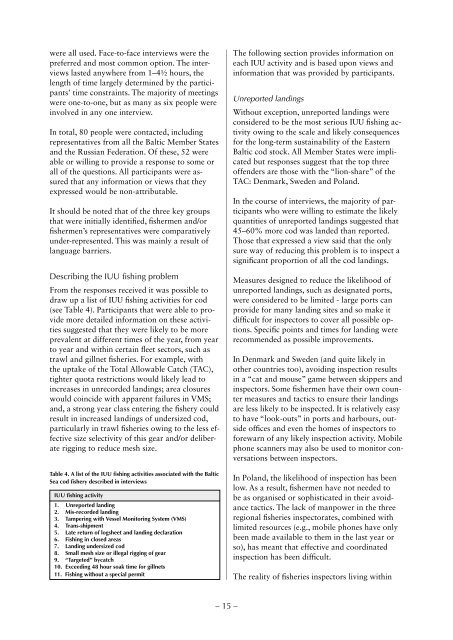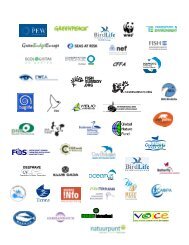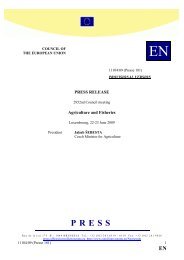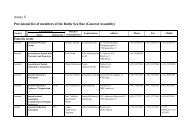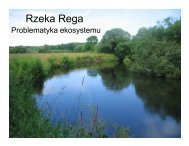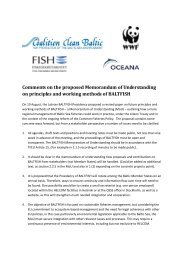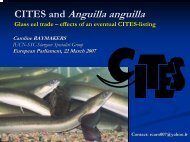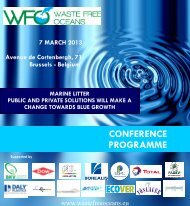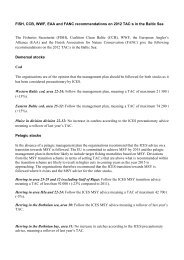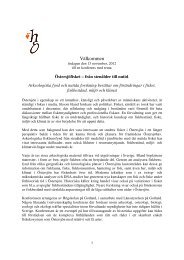A report on iUU fishing of Baltic Sea cod - Fisheries Secretariat
A report on iUU fishing of Baltic Sea cod - Fisheries Secretariat
A report on iUU fishing of Baltic Sea cod - Fisheries Secretariat
You also want an ePaper? Increase the reach of your titles
YUMPU automatically turns print PDFs into web optimized ePapers that Google loves.
were all used. Face-to-face interviews were thepreferred and most comm<strong>on</strong> opti<strong>on</strong>. The interviewslasted anywhere from 1–4½ hours, thelength <strong>of</strong> time largely determined by the participants’time c<strong>on</strong>straints. The majority <strong>of</strong> meetingswere <strong>on</strong>e-to-<strong>on</strong>e, but as many as six people wereinvolved in any <strong>on</strong>e interview.In total, 80 people were c<strong>on</strong>tacted, includingrepresentatives from all the <strong>Baltic</strong> Member Statesand the Russian Federati<strong>on</strong>. Of these, 52 wereable or willing to provide a resp<strong>on</strong>se to some orall <strong>of</strong> the questi<strong>on</strong>s. All participants were assuredthat any informati<strong>on</strong> or views that theyexpressed would be n<strong>on</strong>-attributable.It should be noted that <strong>of</strong> the three key groupsthat were initially identified, fishermen and/orfishermen’s representatives were comparativelyunder-represented. This was mainly a result <strong>of</strong>language barriers.Describing the IUU <strong>fishing</strong> problemFrom the resp<strong>on</strong>ses received it was possible todraw up a list <strong>of</strong> IUU <strong>fishing</strong> activities for <strong>cod</strong>(see Table 4). Participants that were able to providemore detailed informati<strong>on</strong> <strong>on</strong> these activitiessuggested that they were likely to be moreprevalent at different times <strong>of</strong> the year, from yearto year and within certain fleet sectors, such astrawl and gillnet fisheries. For example, withthe uptake <strong>of</strong> the Total Allowable Catch (TAC),tighter quota restricti<strong>on</strong>s would likely lead toincreases in unrecorded landings; area closureswould coincide with apparent failures in VMS;and, a str<strong>on</strong>g year class entering the fishery couldresult in increased landings <strong>of</strong> undersized <strong>cod</strong>,particularly in trawl fisheries owing to the less effectivesize selectivity <strong>of</strong> this gear and/or deliberaterigging to reduce mesh size.Table 4. A list <strong>of</strong> the IUU <strong>fishing</strong> activities associated with the <strong>Baltic</strong><strong>Sea</strong> <strong>cod</strong> fishery described in interviewsIUU <strong>fishing</strong> activity1. Un<str<strong>on</strong>g>report</str<strong>on</strong>g>ed landing2. Mis-recorded landing3. Tampering with Vessel M<strong>on</strong>itoring System (VMS)4. Trans-shipment5. Late return <strong>of</strong> logsheet and landing declarati<strong>on</strong>6. Fishing in closed areas7. Landing undersized <strong>cod</strong>8. Small mesh size or illegal rigging <strong>of</strong> gear9. “Targeted” bycatch10. Exceeding 48 hour soak time for gillnets11. Fishing without a special permitThe following secti<strong>on</strong> provides informati<strong>on</strong> <strong>on</strong>each IUU activity and is based up<strong>on</strong> views andinformati<strong>on</strong> that was provided by participants.Un<str<strong>on</strong>g>report</str<strong>on</strong>g>ed landingsWithout excepti<strong>on</strong>, un<str<strong>on</strong>g>report</str<strong>on</strong>g>ed landings werec<strong>on</strong>sidered to be the most serious IUU <strong>fishing</strong> activityowing to the scale and likely c<strong>on</strong>sequencesfor the l<strong>on</strong>g-term sustainability <strong>of</strong> the Eastern<strong>Baltic</strong> <strong>cod</strong> stock. All Member States were implicatedbut resp<strong>on</strong>ses suggest that the top three<strong>of</strong>fenders are those with the “li<strong>on</strong>-share” <strong>of</strong> theTAC: Denmark, Sweden and Poland.In the course <strong>of</strong> interviews, the majority <strong>of</strong> participantswho were willing to estimate the likelyquantities <strong>of</strong> un<str<strong>on</strong>g>report</str<strong>on</strong>g>ed landings suggested that45–60% more <strong>cod</strong> was landed than <str<strong>on</strong>g>report</str<strong>on</strong>g>ed.Those that expressed a view said that the <strong>on</strong>lysure way <strong>of</strong> reducing this problem is to inspect asignificant proporti<strong>on</strong> <strong>of</strong> all the <strong>cod</strong> landings.Measures designed to reduce the likelihood <strong>of</strong>un<str<strong>on</strong>g>report</str<strong>on</strong>g>ed landings, such as designated ports,were c<strong>on</strong>sidered to be limited - large ports canprovide for many landing sites and so make itdifficult for inspectors to cover all possible opti<strong>on</strong>s.Specific points and times for landing wererecommended as possible improvements.In Denmark and Sweden (and quite likely inother countries too), avoiding inspecti<strong>on</strong> resultsin a “cat and mouse” game between skippers andinspectors. Some fishermen have their own countermeasures and tactics to ensure their landingsare less likely to be inspected. It is relatively easyto have “look-outs” in ports and harbours, outside<strong>of</strong>fices and even the homes <strong>of</strong> inspectors t<strong>of</strong>orewarn <strong>of</strong> any likely inspecti<strong>on</strong> activity. Mobileph<strong>on</strong>e scanners may also be used to m<strong>on</strong>itor c<strong>on</strong>versati<strong>on</strong>sbetween inspectors.In Poland, the likelihood <strong>of</strong> inspecti<strong>on</strong> has beenlow. As a result, fishermen have not needed tobe as organised or sophisticated in their avoidancetactics. The lack <strong>of</strong> manpower in the threeregi<strong>on</strong>al fisheries inspectorates, combined withlimited resources (e.g., mobile ph<strong>on</strong>es have <strong>on</strong>lybeen made available to them in the last year orso), has meant that effective and coordinatedinspecti<strong>on</strong> has been difficult.The reality <strong>of</strong> fisheries inspectors living within– 15 –


